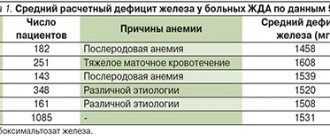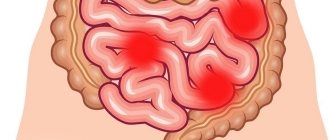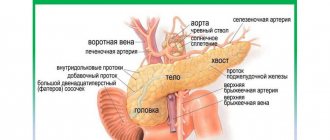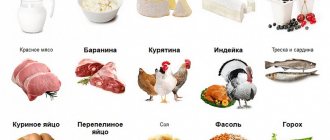Types of iron-containing drugs
Pharmacological companies offer a wide range of medicines and dietary supplements containing iron. The first group is prescribed for treatment, since the medications have a higher dosage of the main active ingredients. Supplements are used to prevent iron deficiency and maintain it within normal limits.
Main types:
- Iron tablets. Medicines contain ferrous iron in the form of ferrous gluconate or ferrous sulfate. The second substance has a little more iron, but the difference is smoothed out by selecting the dosage. The effectiveness of both substances is approximately the same. Iron tablets should not be prescribed to yourself, as they are used to treat confirmed anemia. Medicines have side effects and contraindications, but they are fast-acting and easy to digest. If you take the tablets for 14-28 days, you can significantly improve your hemoglobin level.
- Iron in vitamin complexes. Multivitamins can help with mild anemia, but are not suitable for treating severe conditions. In pharmacies you can buy complex preparations with ferric iron. The substance is less digestible, but easier to tolerate. To achieve an effect, the duration of use should be from two to three months. The effect of taking iron as part of vitamin complexes is enhanced by the presence of other minerals and vitamins - ascorbic and folic acids, vitamin B12, copper, manganese.
- Biologically active additives. Vitamins can also be classified as dietary supplements. However, dietary supplements with iron may contain extracts of medicinal herbs, as well as vitamin compounds. To increase vitality, supplements may contain eleutherococcus or ginseng extract. A permanent or course treatment is indicated.
Epidemiology
IDA was first described by the German physician J. Lange in 1554, and drugs for its treatment were first used by T. Sydenham in the 17th century. Anemia that develops as a result of iron deficiency in the body is the most widespread in clinical practice. According to WHO, about 2.5 billion people on Earth have hidden iron deficiency and 1 billion people suffer from IDA.
In women it is observed 2–5 times more often than in men; children are in 2nd place in frequency of occurrence.
The influence of IDA on the increase in the incidence of maternal and child mortality has been reliably proven. IDA occurs in 12–13% of children aged 6 months and older. up to 2 years. In developing countries, this figure is much higher: in India and African countries it reaches 72–76%. In developed countries of Europe and North America, IDA is detected in 7.5–11% of all women of childbearing age, and 20–25% have hidden tissue iron deficiency. The frequency of IDA is significantly higher in the countries of Asia, Africa and Latin America, where it reaches epidemic levels and amounts to 45–60%. Of all anemias encountered in clinical practice, about 80% are iron deficiency. In the Russian Federation, there is no information on the frequency of IDA, however, according to our data, in Moscow its frequency is 30–35% among women of childbearing age, and hidden iron deficiency is up to 60%.
In what forms are iron supplements available?
For ease of use by both adults and children, manufacturers produce medications in different forms.
For oral administration we offer:
- pills. The main active ingredients are gradually released in the stomach, the tablets do not irritate the mucous membrane. Pros: the effect is independent of food intake, you can take it with you, it’s convenient to take. The downside is that iron from tablets has lower absorption compared to other forms. It is better to find out from your doctor which iron tablets are best to choose;
- syrups. Suitable for babies and older children. The viscous consistency promotes envelopment of the stomach walls and rapid and complete absorption. Disadvantages - they may have an unpleasant taste, and with a high iron content they can stain teeth. Contains sugar and is not suitable for people with diabetes;
- capsules. They are convenient for adults to take, but dissolution in the stomach can cause discomfort. The capsule is indivisible and is not suitable for use by small children.
- hematogen. Can be used by children and adults, has a pleasant taste and is well absorbed. Abuse must be avoided and age-specific dosages must be observed.
Iron is also available in the form of chewable tablets, drops, and powders for preparing solutions.
In a hospital setting, treatment can be carried out by injection into a vein, into a muscle, or using systems using iron-containing solutions. The choice in favor of parenteral administration is made in situations that threaten the patient’s life, as well as when it is impossible or ineffective to use drugs for oral administration.
Stages of iron deficiency
Currently, there are several stages of iron deficiency:
1. Predisposition to the development of iron deficiency (vegetarianism, adolescence in combination with menstrual irregularities in girls, frequent childbirth, the presence of chronic diseases of the gastrointestinal tract or female reproductive system associated with blood loss).
2. Pre-latent iron deficiency. At this stage there are no laboratory criteria for iron deficiency, however, an increase in the absorption of 59Fe3+ in the gastrointestinal tract can be determined, which can exceed 50% (normally 10-15%).
3. Latent iron deficiency. It is characterized by the development of sideropenic syndrome, a decrease in iron reserves in the body according to laboratory tests.
4. WAITING. The diagnosis is established when the hemoglobin concentration decreases to less than 120 g/l in women and 130 g/l in men.
Review of drugs for anemia
Pharmacies offer a wide range of medicines that increase hemoglobin. The most frequently prescribed by doctors are:
- Fenyuls in capsules. Indicated for regular blood loss, to replenish iron deficiency. Contains B vitamins and ascorbic acid. You can buy capsules inexpensively in the online store. The price for a pack of 30 pieces starts from 250 rubles;
- Ferrum-Lek in the form of chewable tablets, syrup, solution for intramuscular administration. Intended for the treatment of hidden iron deficiency, the treatment of anemia, and is suitable for preventing the development of anemia in pregnant women. The syrup is allowed for small children. You can reserve medications on the store’s website. Information about prices, promotions, discounts and available drugs is also available there;
- Maltofer in drops, tablets, syrup, solution for intramuscular administration. In the form of drops, it is used to treat anemia in newborns and premature babies. Tablets are allowed from 12 years of age;
- Ferretab capsules. They have a prolonged effect and contain folic acid. Suitable for pregnant women. One capsule per day is enough. The cost of 30 pieces starts from 380 rubles. You can quickly order and pay for your purchase directly on the website at a time convenient for you.
- Sorbifer Durules tablets. It is prescribed for anemia and iron deficiency, and is also indicated for preventive purposes for pregnant, lactating women and donors. Can be used in children from 12 years of age. For prevention, one tablet per day is enough. Additionally contains ascorbic acid.
The choice of an iron-containing drug should be entrusted to a doctor, who will prescribe a blood test and, based on the results, choose the appropriate medication.
Modern approaches to the treatment of iron deficiency anemia in patients with gynecological pathology
Anemia is a pathological condition characterized by a decrease in hemoglobin concentration and often accompanied by a decrease in the number of red blood cells per unit volume of blood [1]. According to the Ministry of Health of the Russian Federation, over the past 10 years, the frequency of anemia has increased 6.3 times, with iron deficiency anemia (IDA) being the most common (about 90% of all anemia). IDA is a hypochromic microcytic anemia that occurs as a result of a decrease in iron content in the body and is an independent nosological form [2].
In clinical practice, the most common classification of anemia is:
1) anemia caused by acute blood loss (posthemorrhagic); 2) anemia due to impaired erythrocyte production (aplastic, iron-deficient, megaloblastic, sideroblastic, etc.); 3) anemia due to increased destruction of red blood cells (hemolytic).
Depending on the severity of the decrease in hemoglobin levels, three degrees of severity of anemia are distinguished:
- mild - hemoglobin level above 90 g/l;
- average - hemoglobin within 90–70 g/l;
- severe - hemoglobin level less than 70 g/l.
The prevalence of iron deficiency conditions (IDC) in women of childbearing age in some regions of the Russian Federation reaches 30–60%, and according to the World Health Organization, the total number of people with iron deficiency in the world is about 600 million people [3]. VDNs cause increased susceptibility to acute respiratory viral infections and decreased performance.
In gynecology, there are three stages of VDS in the body:
- Prelatent iron deficiency is a hidden iron deficiency; the body accumulates iron with the help of ferritin, an iron-containing protein. If its indicator is low, then they speak of the presence of prelatent iron deficiency.
- Latent iron deficiency - at this stage, along with ferritin, tissue reserves of iron are depleted with optimal hemoglobin levels, no clinical symptoms of iron deficiency are observed, a compensatory increase in iron absorption occurs in the intestine, and the activity of iron-containing enzymes gradually decreases.
- Explicit iron deficiency is characterized by a decrease in the number of erythrocytes and a decrease in the level of hemoglobin, which is part of erythrocytes and is a substance that transports oxygen to the body tissues from the lungs, the development of dystrophic changes in organs and tissues, as well as an increased amount of protoporphyrin in erythrocytes [2, 4] .
The high prevalence of anemia among women is due to the fact that the female body always experiences a lack of iron due to regular blood loss. The human body is designed in such a way that it can recover only 2 mg of this mineral per day from food, subject to proper nutrition (eating enough vegetables and meat) [2]. Thus, menstrual blood loss, despite its “objectivity,” can cause the development of iron deficiency in a woman’s body. During menstruation, normal blood loss is 30–50 ml, and the body loses 15 mg of iron [4, 5]. And if menstruation is heavy and lasts more than 7 days, then iron loss is more than 50 mg. As a consequence, in such cases the need for iron increases many times [6].
Iron deficiency occurs more often in women aged 30–40 years. As a rule, this occurs during pregnancy and breastfeeding (both the fetus and the infant directly receive iron from the mother). We also must not forget about blood loss during childbirth. Women may not be aware that they have a similar problem, although they regularly undergo blood tests during pregnancy. Iron deficiency in the body is diagnosed, unfortunately, only at the third stage. Most women get tired quite quickly and feel overwhelmed even with a slight decrease in ferritin levels. When the body lacks iron, dizziness and headaches occur.
In order to replenish iron reserves and restore blood loss during normal erythropoiesis, the iron contained in food is sufficient. During hormone replacement therapy with erythropoiesis-stimulating drugs, adequate intake of iron into the body optimizes the prescribed treatment. It should be noted that in many cases, the intravenous route of iron administration is more effective than the oral route, as it provides the ability to quickly saturate the body with the iron it needs [7]. This is especially important in the treatment of anemia occurring against the background of chronic diseases. The intravenous route of iron administration helps to overcome the blockage of iron absorption from the gastrointestinal tract (GIT) and create its reserve in the body.
IDA is currently a social disease with a fairly wide prevalence. In pregnant women, it is a condition caused by a reduction in iron content in the bone marrow and blood serum due to its high costs for the formation of the fetoplacental complex, as well as redistribution in favor of the fetus. A natural consequence of iron deficiency is a disturbance in the formation of hemoglobin with the development of both hypochromic anemia and trophic tissue disorders.
IDA remains a serious pathology in modern gynecology, as the frequency of this disease does not decrease. In pregnant women, the incidence of anemia varies between 15–80%, and in 98% of women, anemia during pregnancy is of a pronounced iron deficiency nature [2, 8].
Only iron-containing preparations can balance the iron content in the female body.
A lack of enzymes containing iron can cause various trophic changes in the body of a pregnant woman. Along with these changes, cracks appear in the corners of the mouth, yellowness of the palms, nails become brittle, hair falls out, etc. This disease is sometimes manifested by “exotic” gastronomic preferences. In a severe form of iron deficiency, a decrease or increase in blood pressure, swelling, palpitations, and heart failure may occur. The volume of circulating blood increases, the need for oxygen increases, and, as a result, iron deficiency complicates the course of pregnancy and childbirth, which in turn has an extremely negative effect on the development of the fetus.
The main risk factors for the occurrence and development of IDA in pregnant women include the presence of chronic diseases or anemia before pregnancy, chronic diseases of internal organs or infectious diseases, multiple pregnancy, early toxicosis, hemoglobin level less than 120 g/l in the first trimester, duration of menstruation for several years before pregnancy more than 5 days [9].
Every day a woman consumes from 10 to 20 mg of iron with food, of which less than 2 mg is completely absorbed, and during menstruation, up to 75% of healthy women lose from 20 to 30 mg of iron [10, 11]. This amount of iron cannot be absorbed even with its high content in food. Thus, an imbalance occurs, leading to the development of anemia.
During pregnancy, childbirth and breastfeeding, the cumulative loss of iron is approximately 1 g, and it takes approximately 4 years for the female body to replenish its iron supply exclusively from dietary sources. Consequently, if a woman gives birth again during this period, she will inevitably develop iron deficiency [5].
Modern clinical recommendations include the need for all pregnant women to take iron-containing medications in the second and third trimesters of gestation. For adult non-pregnant women, the daily dose (18 mg of iron) is rarely covered solely by diet [4, 9]. That is why, by the beginning of pregnancy, almost half of all women have minimal iron reserves.
According to modern data, at the end of the gestational process, iron deficiency develops without exception in all pregnant women, both in latent and overt form. This is mainly due to the fact that pregnancy is always accompanied by additional iron losses: 320–500 mg of iron is spent on increased cellular metabolism and an increase in hemoglobin, 50 mg of iron for an increase in the size of the uterus, 100 mg of iron for the construction of the placenta, 400–500 mg iron - to the needs of the fetus [6].
As a result, the fetus, taking into account the reserve fund, is provided with sufficient amounts of iron, but pregnant women often develop VHD of varying severity. To assess whether the iron supply corresponds to the norm, the level of serum ferritin is determined, which, if its values are less than 30 μg/L, is considered reduced.
Reduced prenatal hemoglobin concentration (especially iron deficiency) is a risk factor for postpartum hemorrhage, correlating with the severity of the woman’s condition against her background. By using intravenous iron supplements during the prenatal period to correct IDA, doctors strive to minimize both the risk of bleeding and the need for blood transfusions during the perinatal period. In the postnatal period (from 0 to 6 months), iron deficiency is observed in 13% of mothers, and 10% of women are diagnosed with anemia. Oral forms of iron supplements act rather slowly and often do not provide the required effect [2, 11].
Intravenous iron is clearly a safe alternative, reducing both the need for and the volume of blood transfusions. Treatment with intravenous iron supplements can achieve a significant increase in iron stores and significantly increase the concentration of hemoglobin in the blood.
With the exception of severe cases, IDA is treated during pregnancy on an outpatient basis. To treat it, doctors prescribe medications containing this element. As a rule, they are used for a long time (from 15 weeks to 6 months). The level of hemoglobin in the blood rises smoothly, no earlier than the third week from the start of treatment. The indicator returns to normal approximately 2 months after the start of therapy [9, 11]. At the same time, the woman’s health and well-being improves. However, it is important not to interrupt the course of treatment, since as the gestational age increases, the fetus also grows and its iron needs, accordingly, also increase.
We should not forget about the woman’s upcoming birth, which, in turn, entails a significant waste of energy and blood loss. Next comes the period of breastfeeding the baby, which also causes a lack of iron. Therefore, experts recommend continuing maintenance treatment with iron supplements for another 6 months during the postpartum period [11, 12]. In order to determine the lack of iron in the female body in time, the symptoms should be considered both in combination and individually.
Modern studies have shown a high need for transfusions of blood components in patients with severe uterine bleeding, which increases the cost of hospitalization and reduces the overall quality of life. Oral administration of iron-containing drugs to eliminate VDN in women with menorrhagia allows avoiding red blood cell transfusions in all known cases, except for a pronounced drop in hemoglobin levels, when oral forms cannot fully compensate for iron loss [12].
Today in Russia, unfortunately, medications containing large amounts of iron per tablet are widely used. The toxic effects of therapy that manifest themselves in this case were considered inevitable, and in order to prevent them, it was usually recommended to take the drug with food to bind free iron ions and thereby prevent their negative effect on the gastrointestinal tract. The paradox is obvious: significant doses of iron were recommended, but the binding of iron by food proteins at the same time reduced its intake many times over. The resulting therapeutic effect did not depend in any way on the high dose of iron in the drug [5, 6].
When choosing an iron supplement, there are a number of factors to consider. Since ionized iron from the gastrointestinal tract is absorbed exclusively in divalent form and ascorbic acid plays a huge role in this process, its presence in the preparation is extremely important. In hematopoiesis, folic acid is of great importance, which enhances nucleic acid metabolism. Also, cyanocobalamin is important for the normal metabolism of folic acid, which is a key factor in the formation of its active form.
Deficiency of these substances, which occurs quite often with anemia associated with blood loss, leads to disturbances in DNA synthesis in hematopoietic cells, while the inclusion of these components in the drug increases the active absorption of iron in the intestine and its further utilization, and releases additional amounts of ferritin and transferrin [ 13]. As a result, the rate of hemoglobin synthesis increases, and the effectiveness of therapy for both IDA and other IDA increases.
The only iron preparation for intravenous administration in the USSR was Ferrum Lek. In Russia, the following drugs are approved for intravenous replenishment of iron deficiency: Venofer, CosmoFer and Likferr (of which the domestic Venofer). In many countries, new generation drugs with improved characteristics are used - Ferinject (iron carboxymaltose), Ferumoxytol (supermagnetic iron oxide nanoparticles) and Monofer (iron (III) hydroxide oligoisomaltose 1000) [5, 13, 14].
A Danish pharmaceutical company, a global expert in the development of iron-containing drugs, has created a new highly effective iron preparation for intravenous use, with minimal restrictions in its prescription. The organization is working on clinical programs to further confirm the safety, effectiveness and ease of use of Monofer as a modern treatment for IDA.
The drug Monofer (iron (III) hydroxide oligoisomaltose 1000) was created on the basis of matrix structure technology with alternating fragments of oligoisomaltose 1000 and iron (III) hydroxide, which ensures low toxicity of the drug [14, 15]. Due to its low toxicity, Monofer can be prescribed in a high dose, creating the possibility of correcting VSD in just one visit.
The main safety factors of Monofer include: the absence of a test dose, low risk of anaphylactic reactions, minimal risk of toxicity due to the presence of free iron in the drug. The ease of use of Monofer is based on the possibility of high (up to 20 mg/kg) and fast (up to 60 min) infusion rates due to the low toxicity of the drug [15].
The matrix structure of the drug includes tightly bound and stable iron, promoting a slow and controlled release of iron-containing proteins of bioactive iron with minimal risk of toxicity due to the presence of free iron (Fig.) [10].
New generation iron preparations have a lower content of free iron in their composition, in contrast to older iron preparations. Monofer provides for each patient with IDA a convenient dosage range in the form of:
- intravenous drip infusion: 200–1000 mg (prescribed once a week until iron deficiency is completely restored):
a) 11–20 mg/kg – 60 minutes (you must add 100 to 500 ml of sterile NaCl solution 0.9%); b) 6–10 mg/kg – 30 minutes; c) 0–5 mg/kg – 15 minutes;
- intravenous bolus injection: 100–200 mg per week up to 3 times (rate 50 mg/min). Can also be dissolved in 10–20 ml of sterile 0.9% NaCl solution [12].
If the patient's need for iron replenishment exceeds 20 mg/kg, the dose of Monofer must be divided and prescribed with a time interval of at least one week. Infusions of the drug over 1000 mg are prescribed exclusively in hospital settings. The drug should be prescribed to patients with a diagnosis of IDA, confirmed by appropriate laboratory data (results of determining the concentration of hematocrit and hemoglobin, serum ferritin, the number of red blood cells and their parameters - the average content of hemoglobin in an erythrocyte, the average volume of an erythrocyte or the average concentration of hemoglobin in an erythrocyte).
It should be noted that in one syringe Monofer can be mixed exclusively with sterile saline solution. It is prohibited to add other therapeutic drugs and solutions for administration, as there is a risk of not only precipitation, but also other pharmaceutical interactions.
It is important to avoid penetration of the drug into the perivenous space, since its entry beyond the boundaries of the vessel leads to brown discoloration of the skin and tissue necrosis. In case of such complications, to speed up the removal of iron and prevent its deeper penetration into nearby tissues, it is recommended to apply a heparin-containing drug to the injection site (the ointment or gel is applied without rubbing, with light movements) [16].
Contraindications to the use of the drug:
- non-iron deficiency anemia (eg, hemolytic anemia);
- high sensitivity to the active substance and excipients included in the drug;
- the presence of various signs of iron overload (hemosiderosis, hemochromatosis) or disruption of iron utilization processes;
- rheumatoid arthritis in combination with symptoms of inflammatory processes;
- cirrhosis and hepatitis of the liver (stage of decompensation);
- bacteremia;
- children under 18 years of age (due to insufficient proven data on safety and effectiveness) [3].
Iron preparations administered parenterally can cause hypersensitivity reactions, in particular anaphylactic shock, due to the risk of developing allergic reactions in patients with eczema, polyvalent allergies, bronchial asthma, allergic reactions to other parenteral iron preparations, with systemic lupus erythematosus, acute and chronic infectious diseases, rheumatoid arthritis, etc. the use of the drug is limited. Episodes of a sudden significant decrease in blood pressure are also possible with a high rate of administration of Monofer.
Thus, the use of the drug is recommended in clinically justified cases. It is important to carefully evaluate the benefit/risk ratio to decide on the use of Monofer during pregnancy. If the expected benefit to the mother outweighs the risk to the fetus, then treatment can be carried out in the second and third trimesters of pregnancy. The use of the drug in the first trimester of pregnancy is not recommended [3, 17].
The excretion of Monofer into breast milk has not been established to date. Therefore, the drug can be used during lactation.
Monofer should not be prescribed simultaneously with various dosage forms of iron for oral administration, since their combined use helps reduce the absorption of iron from the gastrointestinal tract. Treatment with oral iron supplements begins no earlier than 5 days after the last injection. The drug is well tolerated and has low toxicity. In this regard, the risk of overdose is minimal. However, an overdose can develop due to acute iron overload or iron accumulation and is expressed by symptoms of hemosiderosis. The level of iron in the body is monitored by determining the degree of ferritin concentration.
The obtained research results showed that the prevention of anemia in women with the drug Monofer helps to reduce the incidence of various diseases associated with iron deficiency [18]. In addition, in the absence of IDA, circulatory and hemic hypoxia disappears, which, in turn, prevents the development of metabolic disorders and leads to a decrease in the incidence of complications such as fetoplacental insufficiency, gestosis, premature birth and labor anomalies. The absence of severe side effects of the drug and a convenient dosage regimen indicate that Monofer is well tolerated.
Thus, among the main advantages of Monofer in gynecology are the following: a wide range of indications for use, convenient dosing and a high safety profile. The use of Monofer ensures high effectiveness of both prevention and treatment of IDA.
Today, there is a large evidence base from various clinical studies confirming the effectiveness and safety of intravenous iron administration in a variety of clinical situations associated with various VDNs. Analysis of studies comparing the results of oral and intravenous forms of iron supplementation indicates equal or higher effectiveness of the latter form. Also, modern studies emphasize such disadvantages of the oral form of administration of iron-containing drugs as side effects, non-compliance with doctor’s instructions, low absorption, as well as the impossibility of prompt compensation for iron loss and maintaining its adequate concentration, characteristic of patients with ongoing blood loss.
The introduction into clinical practice of isomaltose hydroxide 1000, which does not require a test dose, with the possibility of parenteral administration in a short time of high doses, brings additional advantages in therapy with intravenous iron preparations. Also, unlike the oral form, it is the intravenous route of administration of iron supplements that allows one to overcome anemia that develops against the background of chronic diseases.
Literature
- Kulikov A. Yu., Skripnik A. R. Pharmacoeconomic analysis of the drug “Monofer” in the treatment of iron deficiency anemia // Pharmacoeconomics: theory and practice. 2021, 4: 183–186.
- Lebedev V. A., Pashkov V. M. Principles of treatment of iron deficiency anemia in gynecological patients // Difficult patient. 2013, 11: 3–7.
- Nordfjeld K., Andreasen H. Pharmacokinetics of iron isomaltoside 1000 in patients with inflammatory bowel disease // Drug. Des. Devel. Therapy. 2012, 6: 43–51.
- Malkoch A.V., Anastasevich L.A., Filatova N.N. Iron deficiency conditions and iron deficiency anemia in women of childbearing age // Attending Physician. 2013; 4:37–41.
- Mubarakshina O. A., Somova M. N., Lyubavskaya S. S. Pharmacological correction of iron and magnesium deficiency during pregnancy. Voronezh State Medical Academy named after. N. N. Burdenko. 2014; 4:52–60.
- Podzolkova N.M., Nesterova A.A. Iron deficiency anemia in pregnant women // Russian Medical Journal. 2003, 5: 326–331.
- Morrison J., Patel ST, Watson W. Assessment of the prevalence and impact of anemia on women hospitalized for gynecologic conditions associated with heavy uterine bleeding // J. Reprod. Med. 2008, 5: 323–330.
- Protopopova T. A. Iron deficiency anemia and pregnancy // Russian Medical Journal. 2012; 17:862–867.
- Chushkov Yu. V. Modern possibilities for correcting iron deficiency in obstetrics and gynecology // Gynecology. 2011; 6:44–47.
- Bhandari S. A hospital-based cost minimization study of the potential financial impact on the UK health care system of introduction of iron isomaltoside 1000 // Clin Risk Manag. 2011, 7: 103–113.
- Dvoretsky L.I. Algorithms for the diagnosis and treatment of anemia // Russian Medical Journal. 2003, 8: 427–433.
- Coyne D. From anemia trials to clinical practice: understanding the risks and benefits when setting goals for therapy // Semin Dial. 2008, 21: 212–216.
- Lebedev V. A., Pashkov V. M. Principles of treatment of iron deficiency anemia in gynecological patients // Difficult patient. 2013, 11: 3–7.
- Gupta DR, Larson DS, Thomsen LL Pharmacokinetics of Iron Isomaltoside1000 in Patients with Stage 5 Chronic Kidney Disease on Dialysis Therapy. 2013, 03: 4172/2157–7609.
- Hildebrant P., Brunn N. et al. Effects of administration of iron isomaltoside 1000 in patients with chronic heart failure. A pilot study. Transfusion Alternatives in Transfusion Medicine // 2010, 11: 131–137.
- Locatelli F. Iron treatment and the TREAT trial // NDT +. 2011, 4: 13–15.
- Pasricha SR, Flecknoe-Brown SC Diagnosis and management of iron deficiency anemia: a clinical update. 2010, 9: 50–62.
- Philip A. Kalra, Sunil Bhandari, Sanjiv Saxena. A randomized trial of iron isomaltoside 1000 versus oral iron in non-dialysis-dependent chronic kidney disease patients with anemia // Nephrol Dial Transplant. 2015, 3: 1–10.
A. Z. Khashukoeva*, 1, Doctor of Medical Sciences, Professor M. I. Agaeva* M. Z. Dugieva*, Doctor of Medical Sciences T. N. Sukhova** L. I. Abdurakhmanova*
* Federal State Budgetary Educational Institution of the Russian National Research University named after. N. I. Pirogova Ministry of Health of the Russian Federation, Moscow ** OSP RGNKTs Federal State Budgetary Educational Institution of Higher Education Russian National Research Medical University named after. N. I. Pirogova Ministry of Health of the Russian Federation, Moscow
1 Contact information
Modern approaches to the treatment of iron deficiency anemia in patients with gynecological pathology / A. Z. Khashukoeva, M. I. Agaeva, M. Z. Dugieva, T. N. Sukhova, L. I. Abdurakhmanova
For citation: Attending physician No. 12/2017; Issue page numbers: 23-29
Tags: women, iron, intravenous drugs











